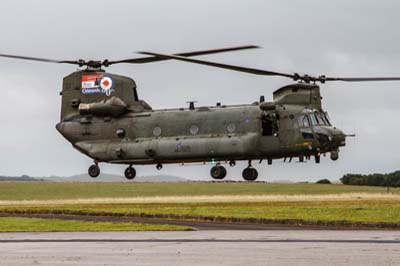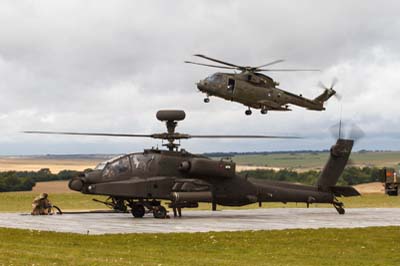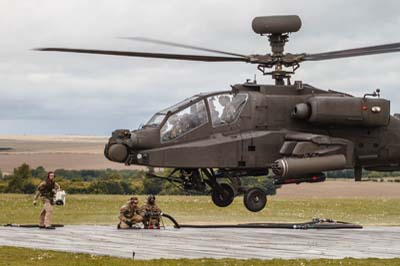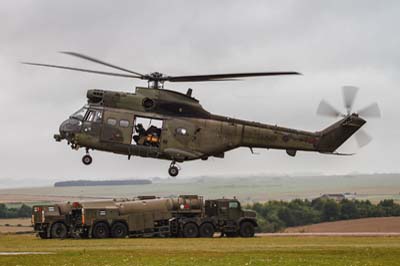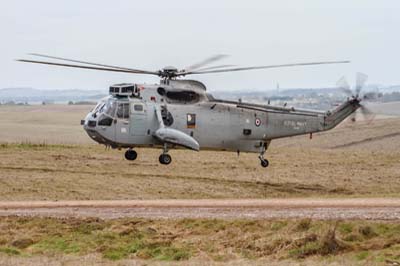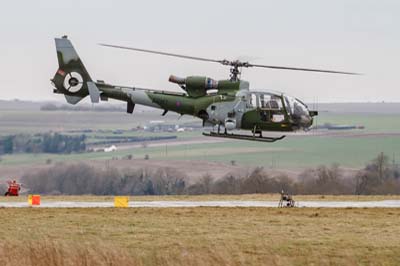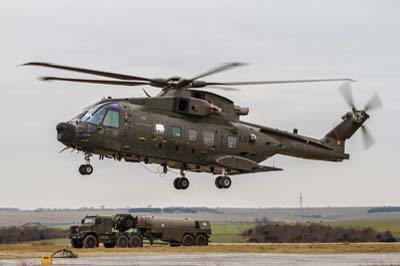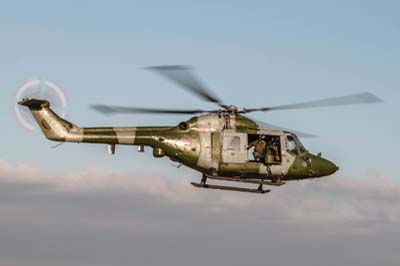Salisbury Plain Training Area (SPTA
Exercise 'Pashtun Jaguar'
January/February and July/August 2011
|
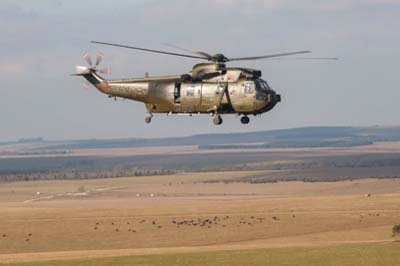 The Mission Rehearsal Exercise (MRX) named 'Pashtun Jaguar' enables Joint Helicopter Command (JHC) to work with UK ground forces for almost a month on the Salisbury Plain Training Area (SPTA). Mission scenarios take place over a large area within the SPTA centred around Netheravon Camp which is replicating Camp Bastion in Afghanistan. These six monthly Final Training Exercises (FTX) run simulaneously with ground force exercises (such as 'Pashtun Dagger' in January and 'Pashtun Dawn' in August).
The Mission Rehearsal Exercise (MRX) named 'Pashtun Jaguar' enables Joint Helicopter Command (JHC) to work with UK ground forces for almost a month on the Salisbury Plain Training Area (SPTA). Mission scenarios take place over a large area within the SPTA centred around Netheravon Camp which is replicating Camp Bastion in Afghanistan. These six monthly Final Training Exercises (FTX) run simulaneously with ground force exercises (such as 'Pashtun Dagger' in January and 'Pashtun Dawn' in August).
Colonel Neil Sexton, Assistant Director Operations JHC explained the reasoning behind the joint exercies which involve all three services; "They [ground forces] are being trained on the use of helicopters not just the getting in and out or controlling the Apache but the interlectural process of using of aviation in a senisble way in Afghanistan." He added; "We need to validate our people to make sure they are fit and ready to go to Afghanistan. This in includes the aircrew and the Head Quarters staff. It is important to control and make risk assessments. For example; whether to launch or not to launch when the visibility is down to 1,500 meters in a sand storm and there is an injured person who needs to be picked up.". |
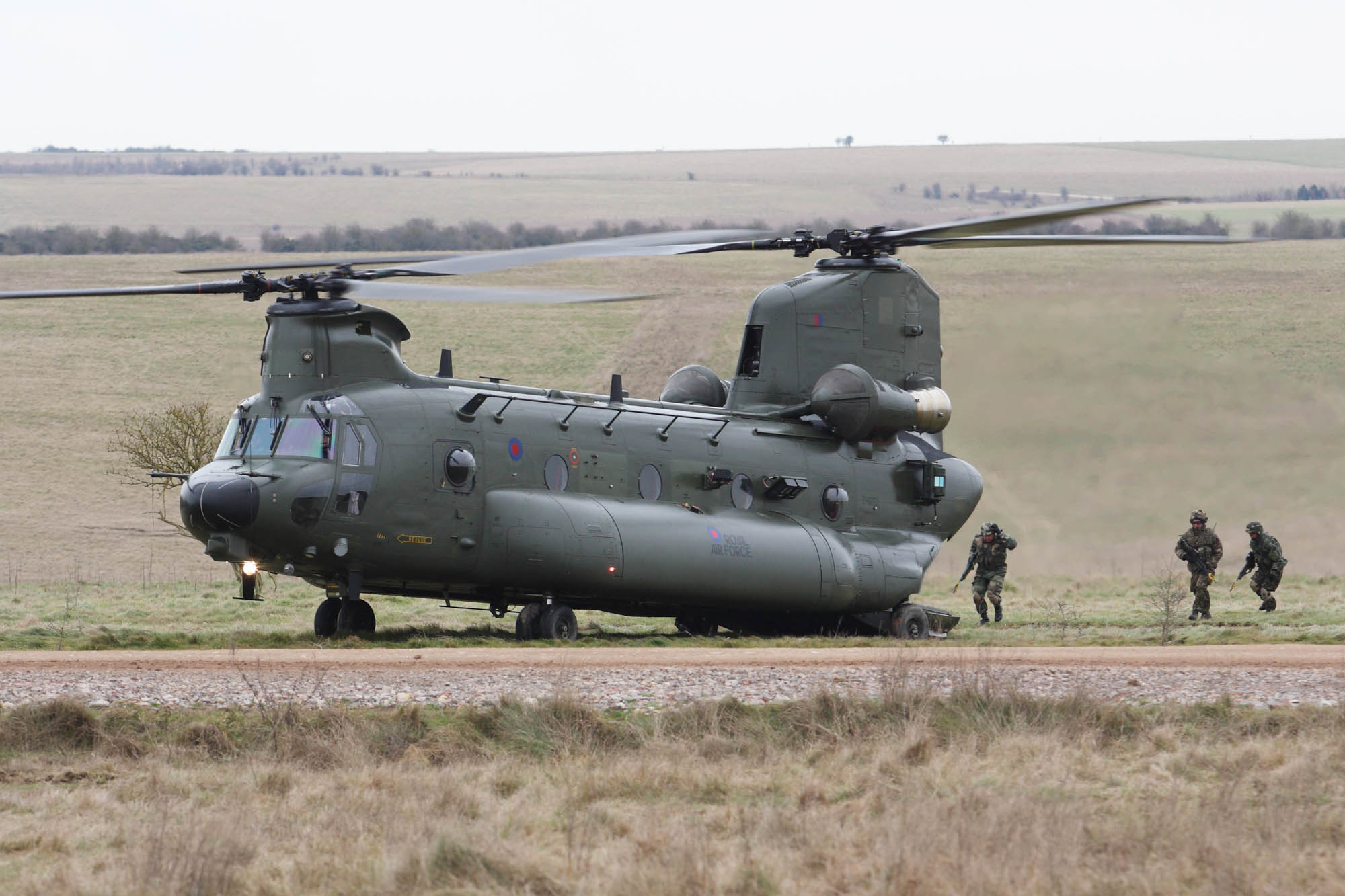 |
| Chinook HC.3 (ZH902) operated by 18/27 Squadron of Odiham Wing on the Joint Helicopter Command with troops from 42 Commando Royal Marines embarking during a 'shura' at Copehill Down. |
Pashtun Dawn (July 24 to August 22)
The emphasis of this exercise is for the training of 20 Armoured Brigade (20 Armd Bde). Consisting of two battle groups each of 700-1000 people, the Pashtun Dawn comprised three nine day events including air assualts involving all three Services in preparation to their tour to Afghanistan next month as Operation Herrick 15.
Pashtun Dagger (January 24 to February 11)
Colonel Neil Sexton, the Assistant Director of Operations for the exercise, said: "It is all about training our people in the JHC for Afghanistan. This exercise has a number of objectives with two central aims, firstly to support the 3 Commando Brigade (3 Cdo) exercise [Pashtun Dagger] which is going on all over Salisbury Plain, but also to validate our own crews in the roles they will play in Afghanistan." 'Task Force Helmand' were put through their paces on Salisbury Plain under exercise Pashtun Dagger to prepare for their deployment to Afghanistan in April 2011 as Operation Herrick 14. The Joint Task Force was led by 3 Cdo and supported by units from 7 Armoured Brigade, in all 6,500 service men and women from across the services will be deployed to Afghanistan. Pashtun Dagger utilised around 2,500 troops and 300 tracked and wheeled armoured vehicles many of which formed large convoys of perhaps 80 vehicles.
Brig Ed Davis, Royal Marines, Commander Task Force Helmand 14 speaking at Copehill Down FIBUA (Fighting In Built Up Areas) mock training village, described the training that has led up to the exercise said; "Our main effort is to prepare forces for Afghanistan. It starts with foundation training in Norway, winter and amphibious, Brunei, maritime and jungle, United States, Germany and Canada to train people in their core skills according to the elements of the armed forces they come from. Our aims are to work together to get unit cohesiveness and learn basic fundamentals of war fighting in an aggressive, rapid and in a coordinated manner."
Mission specific training follows involving working with local populations and insurgency and "Now things start to look a lot like Afghanistan" said Brig Davis. The work-up for Operation Herrick 14 finishes with the field training exercise on Salisbury Plain. |
Pashtun Jaguar 11-1 and 11-2
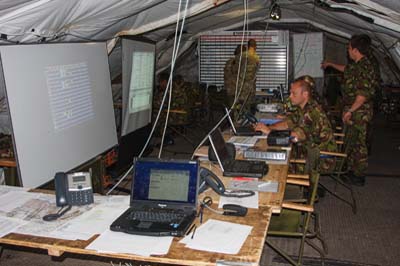 Joint Operations Centre (JOC)
Joint Operations Centre (JOC)
The JOC for the exercise is located in tents at Netheravon it is designed to replicate the operations from Camp Bastion in Afghanistan. Lieutenant Colonel James Anderson heads up the Joint Operations Centre on Exercise Pashtun Jaguar. He explained the rationale behind creating an exact layout of Camp Bastion: "The key point is that the training has to be extremely robust to replicate what we will find in Afghanistan," he said, "because as soon as we get there we've got to hit the ground running and you've got to be very much aware of what the current mood is in theatre and how things have changed."
Colonel Neil Sexton describes the JOC; "We're preparing the headquarters staff in the Joint Operations Centre and then we're training the flying detachments of all the different helicopter types to work in different scenarios to make sure that they have all the right tactics, techniques and procedures and to allow the ground troops to plan and prepare with them to use the helicopters properly."
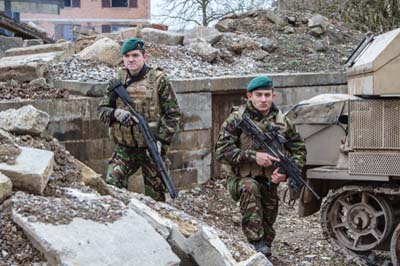 Judgmental Training
Judgmental Training
In Afghanistan the Joint Aviation Group (JAG) integrates assets of the US Marines with those of Joint Helicopter Force Afghanistan (JHF(A)) at Camp Leatherneck in Afghanistan. Encompassed within exercise Pashtun Jaguar is the validation of JHF(A), it focussed on joint planning, briefing and execution and what is termed term ‘Judgmental Training’ (JT). JT was introduced as a mandatory requirement for Operation Herrick in 2009 by the Commander of International Security Assistance Force (COMISAF). It is defined as; ‘The training in Use of Force and Rules of Engagement (ROE) addressing both offensive and defensive use of force’.
Colonel Neil Sexton explained how it works in the field in making sure crews know what they can and can’t do; “The exercises contain a huge element of what has come to be known as 'Judgemental Training', which means when an aircrew finds itself in a situation, be it offensive or defensive, the crew must decide whether it is safe, correct and prudent to engage with the enemy. Essentially it is about making sure the crews understand what they can and can't do under the rules of engagement”.
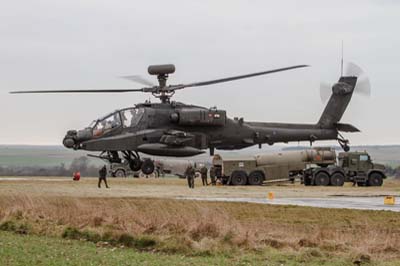 During the exercise to test JT personnel were dressed in Afghan style clothing and weapons and were there to set up a scenario, such as an ambush or the setting up an IED (Improvised Explosive Device). Aircrews were then tasked to investigate, their actions monitored and analysed using video when they returned to Netheravon. In all at least 18 helicopters from JHC took part, each element supported by their own personnel and groundcrew. A total of 437 personnel were supporting the total force consisting of the Army Air Corp’s Westland Lynx AH.7/AH.9 (with 35 supporting personnel), Westland WAH-64 Apache AH.1 (with 132), Eurocopter Gazelle AH.1 (with 10), Royal Air Force AgustaWestland AW-101 Merlin HC.3A (with 20) and Boeing CH-47 Chinook HC.2/HC.3 (with 40) and Royal Navy Westland Sea King HC.4 (with 17). The Tactical Supply Wing who were tasked with delivering the fuel to the thirsty helicopters participated from a Forward Refuelling Point (FRP) with a team of ten personnel camped in an adjacent woodland copse.
During the exercise to test JT personnel were dressed in Afghan style clothing and weapons and were there to set up a scenario, such as an ambush or the setting up an IED (Improvised Explosive Device). Aircrews were then tasked to investigate, their actions monitored and analysed using video when they returned to Netheravon. In all at least 18 helicopters from JHC took part, each element supported by their own personnel and groundcrew. A total of 437 personnel were supporting the total force consisting of the Army Air Corp’s Westland Lynx AH.7/AH.9 (with 35 supporting personnel), Westland WAH-64 Apache AH.1 (with 132), Eurocopter Gazelle AH.1 (with 10), Royal Air Force AgustaWestland AW-101 Merlin HC.3A (with 20) and Boeing CH-47 Chinook HC.2/HC.3 (with 40) and Royal Navy Westland Sea King HC.4 (with 17). The Tactical Supply Wing who were tasked with delivering the fuel to the thirsty helicopters participated from a Forward Refuelling Point (FRP) with a team of ten personnel camped in an adjacent woodland copse.
The helicopter fleet itself consisted of; Sea King (3), Apache (6), Lynx (4), Merlin (2), Chinook (2) and a single Gazelle which was simulating an unmanned aerial vehicle (UAV). Over the course of the exercise, the aircraft it was estimated would have flown for more than 1,000 hours consuming 800,000 litres of aviation fuel.
A Royal Navy Sea King ASaC.7 based at RNAS Culdrose was in the SKASaC (Sea King Airborne Surveillance and Control) role. Currently Sea King ASaC.7’s of 854 Naval Air Squadron is deployed with 903 EAW at Camp Bastion Air Field., They provide enhanced situational awareness for ground commanders involved in Helicopter Assaults and offered planned and dynamic reactive surveillance support to ground forces.
Lift, Find and Strike
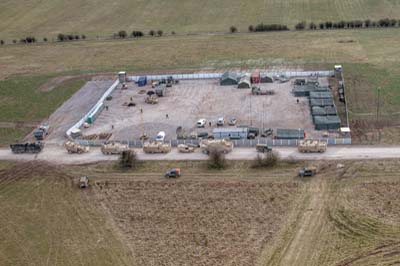
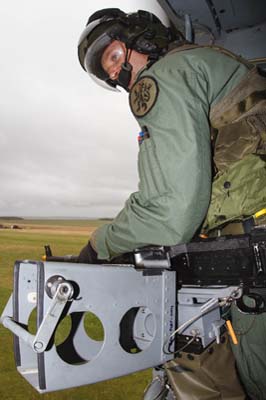 JHF(A) provides three key effects, the first lift, consists of passenger and freight transport and Casualty Evacuation (CASEVAC) and force protection using the Integrated or Medical Emergency Response Teams (IRT/MERT). At Camp Bastion IRT/MERT is tasked with providing a maximum of a 20 minute response during the day and 50 minutes by night. The current average day response is between eight and nine minutes, in which they are briefed and scrambled to the waiting helicopter. While simulated CASEVAC scenarios were being tasked to the aircrew there were other more routine sorties that were flown. Dispersed around the SPTA were a number of Forward Operating Bases (FOB) which had to be supplied with food, water and ammunition on a daily basis.
JHF(A) provides three key effects, the first lift, consists of passenger and freight transport and Casualty Evacuation (CASEVAC) and force protection using the Integrated or Medical Emergency Response Teams (IRT/MERT). At Camp Bastion IRT/MERT is tasked with providing a maximum of a 20 minute response during the day and 50 minutes by night. The current average day response is between eight and nine minutes, in which they are briefed and scrambled to the waiting helicopter. While simulated CASEVAC scenarios were being tasked to the aircrew there were other more routine sorties that were flown. Dispersed around the SPTA were a number of Forward Operating Bases (FOB) which had to be supplied with food, water and ammunition on a daily basis.
Secondly, Strike which is provided by the Apache with its nose mounted 30mm cannon, rockets and AGM-114 Hellfire is an air-to-surface missiles. The Lynx has a Browning M3M 0.5 calibre machine gun mounted on the cabin door.
The third element is ‘find’ using the Apache with their MTADS (Modernized Target Acquisition Designation Sight) developed by Lockheed Martin and Boeing. Also available is the Wescam MX-15 airborne battlefield surveillance camera turret which is fitted to the Lynx and were fully utilised during Pashtun Jaguar.
Pre-Deployment Training (PDT) such as this is essential if our military forces are to deliver what is required out in Afghanistan over their six month tour. Once in Afghanistan our forces will work closely with other participating nations as part of a fully integrated group of ISAF coalition troops and Afghan personnel of the Afghan National Security Forces whom they will eventually handover the responsibilities of national security in their country. |
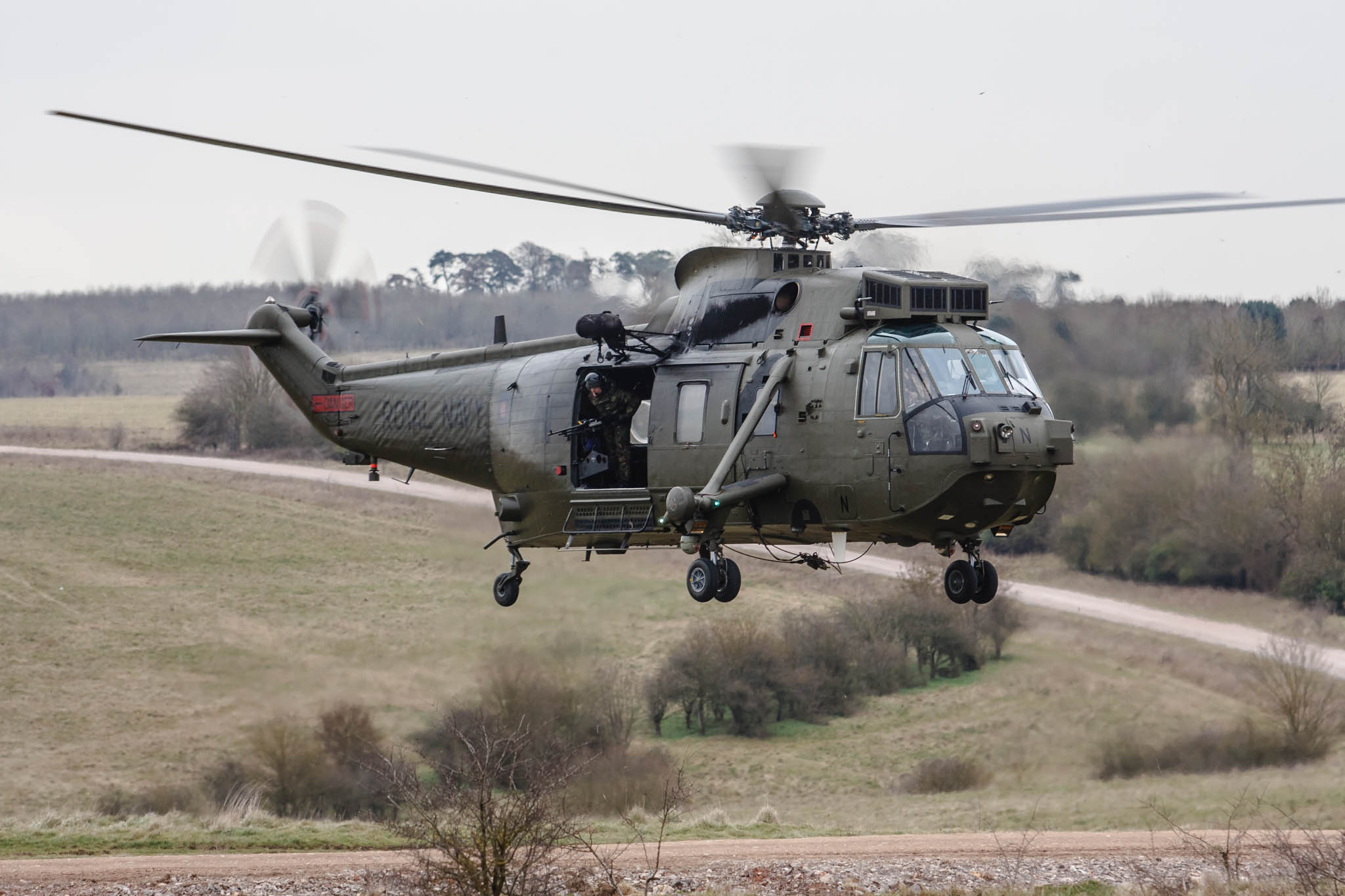 |
| Royal Navy Sea King HC.4 (ZA291 'N') Sea King HC.4 (ZA291 'N') of 848 NAS, there is a Browning M3M 0.5 calibre machine gun mounted on the cabin door. |
| Chinook HC.2 (ZA714 'AV') of 18/27 Squadron of Odiham Wing, Joint Helicopter Command, it has a 'Chinook 30 years' special tail at Netheravon in August. Apache AH.1 and Merlin HC.2 making use of the FRP. Puma HC.1 (XW212) of 33/230 Squadron from RAF Benson. The Puma was utilised during the middle week (FTX 2) only, this is the first time the Puma has participated in MRX exercises. |
Left to right: Sea King ASaC.7 (XV697 '181') of 849 Naval Air Squadron based at RNAS Culdrose it was used in the SKASaC (Sea King Airborne Surveillance and Control) role during the exercise.
Gazelle AH.1 (ZB683) of 651 Squadron, Joint Helicopter Command it was simulating an unmanned aerial vehicle (UAV).
Merlin HC.3A (ZJ990 'AA') of 28/78 Squadron of Benson Wing, Joint Helicopter Command.
Lynx AH.7 (XZ670) it has a Browning M3M 0.5 calibre machine gun mounted on the cabin door. |


